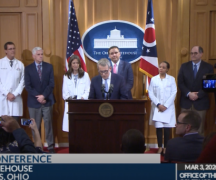There’s been a lot of talk about ways to reduce the cost of prescription drugs. In last week’s State of the Union Address, for example, President Joe Biden proposed allowing Medicare to negotiate directly with drugmakers in an attempt to bring prices down.
A report published Monday says that another, less-sweeping change would save American seniors $18 billion a year — an annual average of about $281 for each senior getting drugs through Medicare Part D. It would do so by changing the way pharmacy middlemen reimburse pharmacies that dispense the drugs, said the report, by drug-pricing consultant 3 Axis Advisors.
A spokesman for the drug middlemen said the consultant has conflicts of interest and that it proposed to use data that aren’t representative of the marketplace.
Murky system
Drug prices in the United States are more than 250% higher than they are in other countries and it might seem logical that the companies making them are to blame. Indeed, through practices such as abusively extending patents on expensive meds, drug companies have been credibly accused of practices that account for at least part of the high prices Americans pay at the pharmacy counter.
But drug pricing is notoriously complex and opaque and other players in the supply chain — wholesalers, purchasing cooperatives, pharmacies and middlemen known as pharmacy benefit managers — play important roles as well.
The 3 Axis Advisors analysis uses data from Medicare Part D, the prescription benefit for seniors, to look at the way pharmacy benefit managers pay for drugs and concludes that the method raises costs for consumers — and taxpayers.
Pharmacy benefit managers, or PBMs, contract with private insurers and programs such as Medicare and Medicaid to manage pharmacy benefits. They negotiate rebates with drugmakers, reconcile claims, create formularies and reimburse pharmacies.
The marketplace is highly concentrated, with the three biggest companies — CVS Caremark, Express Scripts and OptumRx — controlling more than 70%.
It’s so concentrated, in fact, that an effort to get the Federal Trade Commission to mount a major investigation into anticompetitive practices narrowly failed last month on a tie vote. The probe is expected to move forward once the U.S. Senate approves Biden nominee Alvaro Bedoya.
The PBM industry says the big companies use their size and sophistication to negotiate big discounts from manufacturers to the benefit of consumers. But critics say they use a number of non-transparent practices to pocket ever more profit.
Different sets of prices
The 3 Axis Advisors report looked at how PBMs treat drugs as having one price at the pharmacy counter but end up paying less themselves. One way of doing that is by reimbursing pharmacies at one rate and then clawing part of that back in the form of adjustments and fees.
Another is by collecting rebates from drugmakers that consumers don’t benefit from during many stages of their benefits.
Those practices are thought to increase “list prices” for drugs. That’s what you pay if you don’t have any form of insurance. It’s also what you pay if you’re a Medicare Part D recipient and haven’t met your $480 deductible.
And it helps determine what you pay if you enter the Part D program’s infamous “doughnut hole,” a coverage gap that starts once your costs are $4,430 in a given year and ends once they reach $7,050. At that point you become eligible for catastrophic coverageunder which you face coinsurance or a copayment.
In 2017, the U.S. Centers for Medicare and Medicaid Services reported that the difference between costs at the pharmacy counter and what PBMs ultimately paid for drugs was growing and late last year said it would take administrative steps to control the trend.
A single price?
But the 3 Axis Advisors report looked at doing away with that reimbursement method altogether.
Instead of having one price at the counter and jiggering it around later, the analysis looked at basing prices on a public database — National Average Drug Acquisition Cost, or NADAC — and adding a $10 fee to cover pharmacy expenses. In 2021 that would have produced 8.4% or $18.17 billion in out-of-pocket savings for Medicare patients, the analysis said.
It added that it would save untold amounts more for taxpayers by lowering costs at the counter and slowing the rate at which seniors move into catastrophic coverage, when the great majority of their pharmacy bill is footed by the government.
“Efforts to reform Medicare Part D that fail to address inflated out-of-pocket costs for seniors will result in a current problem getting materially worse in the future,” the report said. “Similarly, efforts to reform Medicare that fail to address the incentives that encourage Part D plan sponsors to forgo managing costs at the pharmacy counter, and instead shift costs and risks onto the federal government, will only result in higher costs to the federal budget.”
Greg Lopes, a spokesman for the Pharmaceutical Care Management Association, a PBM industry group, questioned the impartiality of the team performing the analysis and the index they use as an alternative to set prices.
Some of the team’s members have backgrounds in the pharmacy sector and the analysis was done on behalf of two pharmacy groups — the American Pharmacy Cooperative and the American Pharmacists Association. And, since pharmacists have long complained of being under-reimbursed by the big PBMs, the groups could have an interest in having dispensing fees set at $10.
In an email, Lopes said PBMs are working to keep down drug costs. He added that basing drug reimbursements on the one publicly available price list wouldn’t be representative.
“The report’s assertion that NADAC is a correct and accurate pharmacy reimbursement standard is misguided,” he said. “NADAC doesn’t represent the actual price paid for a drug by a pharmacy, rather it’s a national average of reported acquisition costs by a small subset of pharmacies across many drug manufacturer products.”
CMS, the federal agency that runs Medicare and Medicaid, has been looking at reforms to its prescription-drug practices in recent years. On Tuesday, it said it would take a look at the 3 Axis Advisors report.
“As with all relevant and topical research, CMS appreciates the input of the report authors and considers external research in potential future policymaking and initiatives,” a spokeswoman said in an email.
***
Also from Ohio Capital Journal:
Despite criticizing federal spending, some GOP Senate candidates accepted PPP loans
Governor appoints former lawmaker to elections board who hyped up 2020 voter fraud claims
Ohio House considers, reconsiders military absentee ballot measure
Latest Ohio abortion bill would promote experimental ‘reversal’ treatment





